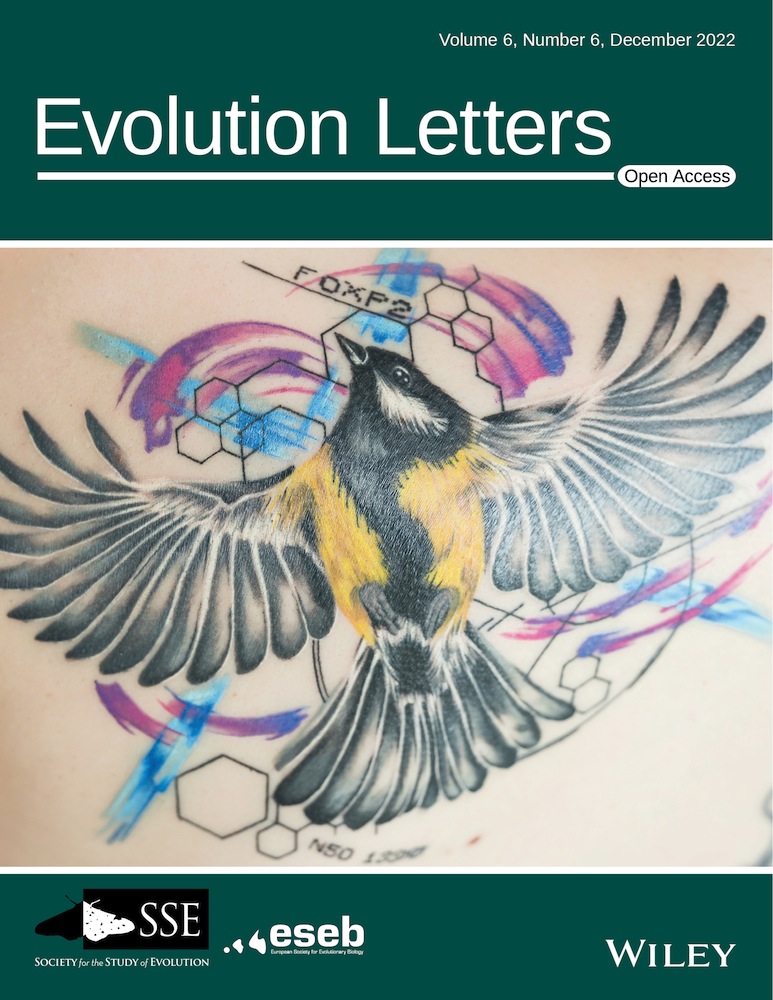Mating environments mediate the evolution of behavioral isolation during ecological speciation
IF 3.4
1区 生物学
Q2 EVOLUTIONARY BIOLOGY
引用次数: 0
Abstract
The evolution of behavioral isolation is often the first step toward speciation. While past studies show that behavioral isolation will sometimes evolve as a by-product of divergent ecological selection, we lack a more nuanced understanding of factors that may promote or hamper its evolution. The environment in which mating occurs may be important in mediating whether behavioral isolation evolves for two reasons. Ecological speciation could occur as a direct outcome of different sexual interactions being favored in different mating environments. Alternatively, mating environments may vary in the constraint they impose on traits underlying mating interactions, such that populations evolving in a “constraining” mating environment would be less likely to evolve behavioral isolation than populations evolving in a less constraining mating environment. In the latter, mating environment is not the direct cause of behavioral isolation but rather permits its evolution only if other drivers are present. We test these ideas with a set of 28 experimental fly populations, each of which evolved under one of two mating environments and one of two larval environments. Counter to the prediction of ecological speciation by mating environment, behavioral isolation was not maximal between populations evolved in different mating environments. Nonetheless, mating environment was an important factor as behavioral isolation evolved among populations from one mating environment but not among populations from the other. Though one mating environment was conducive to the evolution of behavioral isolation, it was not sufficient: assortative mating only evolved between populations adapting to different-larval environments within that mating environment, indicating a role for ecological speciation. Intriguingly, the mating environment that promoted behavioral isolation is characterized by less sexual conflict compared to the other mating environment. Our results suggest that mating environments play a key role in mediating ecological speciation via other axes of divergent selection.交配环境是生态物种演化过程中行为隔离演化的中介
行为隔离的进化往往是物种分化的第一步。尽管过去的研究表明,行为隔离有时会作为生态选择差异的副产品而进化,但我们对可能促进或阻碍其进化的因素缺乏更细致的了解。交配环境可能对行为隔离是否进化具有重要影响,原因有二。在不同的交配环境中,不同的性相互作用受到青睐,这可能会直接导致生态物种的形成。另一种情况是,交配环境对交配互动的基本特征所施加的限制可能不同,因此在 "限制性 "交配环境中进化的种群比在限制性较小的交配环境中进化的种群更不可能进化出行为隔离。在后者中,交配环境并不是行为隔离的直接原因,而是只有在其他驱动因素存在的情况下才会允许行为隔离的进化。我们用一组 28 个实验性苍蝇种群来验证这些观点,每个种群都在两种交配环境和两种幼虫环境中的一种环境下进化。与通过交配环境实现生态种群分化的预测相反,在不同交配环境中进化的种群之间的行为隔离并不是最大的。然而,交配环境是一个重要因素,因为行为隔离在一种交配环境的种群之间发生了进化,而在另一种交配环境的种群之间却没有发生进化。虽然一种交配环境有利于行为隔离的进化,但这还不够:只有在该交配环境中适应不同低龄环境的种群之间才会进化出同类交配,这表明生态物种分化的作用。有趣的是,与其他交配环境相比,促进行为隔离的交配环境中性冲突较少。我们的研究结果表明,交配环境通过其他分化选择轴在调解生态物种分化中起着关键作用。
本文章由计算机程序翻译,如有差异,请以英文原文为准。
求助全文
约1分钟内获得全文
求助全文
来源期刊

Evolution Letters
EVOLUTIONARY BIOLOGY-
CiteScore
13.00
自引率
2.00%
发文量
35
审稿时长
10 weeks
期刊介绍:
Evolution Letters publishes cutting-edge new research in all areas of Evolutionary Biology.
Available exclusively online, and entirely open access, Evolution Letters consists of Letters - original pieces of research which form the bulk of papers - and Comments and Opinion - a forum for highlighting timely new research ideas for the evolutionary community.
 求助内容:
求助内容: 应助结果提醒方式:
应助结果提醒方式:


